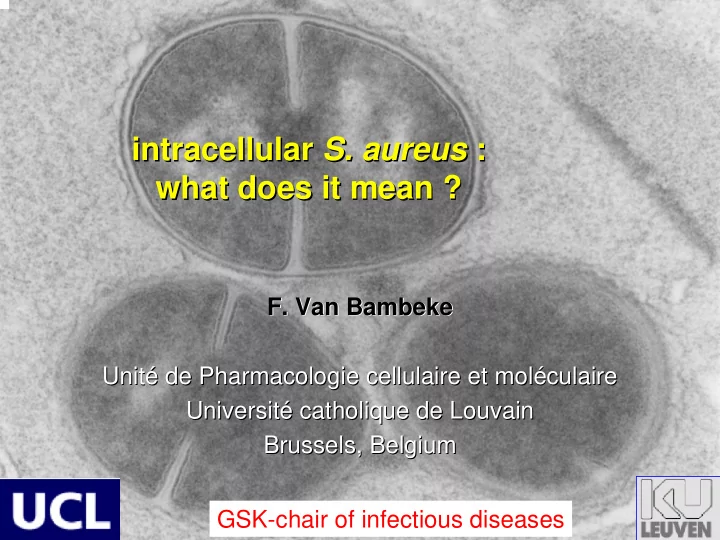

intracellular S. aureus S. aureus : : intracellular what does it mean ? what does it mean ? F. Van Bambeke F. Van Bambeke Unité de Pharmacologie cellulaire et moléculaire Unité de Pharmacologie cellulaire et moléculaire Université catholique de Louvain Université catholique de Louvain Brussels, Belgium Brussels, Belgium GSK-chair of infectious diseases
Intracellular killing of bacteria by host cell defense mechanisms Phagosomes Lysosomes Phagolysosomes
Some bacteria can escape host cell defense mechanisms Carryn et al , Infect Dis Clin North Am. (2003) 17:615-34 Early endosomes Phagosomes Phagosomes Inclusions Mycobacterium spp. Chlamydia spp. Salmonella spp. Brucella spp. Lysosomes Cytosol Listeria monocytogenes Shigella flexeneri Endoplasmic reticulum Phagolysosomes Legionella pneumophila Legionella pneumophila Staphylococcus aureus opportunistic intracellular bacteria
Evidence for intracellular S. aureus in vitro and in vivo – model of mastitis phagocytic cells non phagocytic PMN, cells macrophages Brouillette et al , Vet Microbiol (2004) 101:253-262; Microb Pathog. (2003) 35:159-68.
Intracellular cycle of S. aureus cytotoxicity and adhesion internalisation cellular response FnBP cytokines fibronectin β -integrin actin polymerisation escape In the cytosol apoptosis of host cell Lowy, Trends Microbiol (2000) 8:341-342
Intracellular survival of S. aureus cytotoxicity and adhesion internalisation cellular response FnBP cytokines fibronectin β -integrin actin polymerisation Lowy, Trends Microbiol (2000) 8:341-342
In vivo implication remains however a matter of debate Clearly established in in vitro models Few reports in vivo � low density of intracellular foci � destructive nature of S. aureus infection � multiple mechanisms of adherence and invasion
S. aureus can survive and multiply in phagocytes and several other cell types
But is this associated with pathology ? osteoblasts keratinocytes endothelial cells epithelial cells
In vivo implication remains however a matter of debate Clearly established in in vitro models Few reports in vivo � low density of intracellular foci � destructive nature of S. aureus infection � multiple mechanisms of adherence and invasion Useful to study to understand pathogenesis and explore therapeutic options
Setting up a model of intracellular infection over a 24 h period of time 5 h infection no antibiotic gentamicin 0.5 mg/L • infection of macrophages (with opsonized bacteria) • Mouse (J774; 5 bact/cell) • Human (THP-1; 4 bact/cell) • washing with GEN 50 µg/ml to eliminate extracellular bacteria • incubation for up to 24 h with � GEN 0.5 µg/ml (MIC) � antibiotic under study Seral et al. AAC 2003 47:2283-2292
Description of the model : how does S. aureus grow intracellularly ? extra 4 intra from time 0 h ∆ log CFU 2 0 0 6 12 18 24 time (h) Seral et al. AAC 2003 47:2283-2292
intracellular vs extracellular activity of antibiotics : is it easily predictible ? Intracellular activity = MIC. X accumulation
intracellular vs extracellular activity of antibiotics : PK – PD in action Carryn et al , Infect Dis Clin North Am. (2003) 17:615-34
Intracellular killing is visible for antibiotics control working on cell wall oxacillin oritavancin
Smart choice of antibiotics based on balanced extra- / intra- activity
Intracellular activity : possible reasons for loss of activity AB Cc/Ce Max. activity OXA < 4 -1.6 GEN 4 -2.5 MXF 8 -2.8 AZM 38 -0.2 Drug (lysosomal) ORI 148 -3.2 accumulation
Intracellular activity : possible reasons for loss of activity AB MIC pH 7.4 pH 5.4 AZM 0.5 512 GEN 0.5 16 MXF 0.06 0.25 Lysosomal ORI 0.25 0.25 acidic pH OXA 0.125 0.06
Intracellular activity : possible reasons for loss of activity macrophages exposed to oritavancin bioavailability
Intracellular activity : possible reasons for loss of activity Rapid equilibration by diffusion quinolones beta-lactams access to the infected compartment slow accumulation by endocytosis aminoglycosides glycopeptides
Intracellular activity : possible reasons for loss of activity slow growth extra 4 intra from time 0 h ∆ log CFU 2 0 0 6 12 18 24 time (h) metabolic changes involved in Bacterial responsiveness invasion and toxicity
Take home message
Thanks to … Maritza Maritza Cristina Cristina Barcia- -Macay Macay Barcia Seral Seral Sandrine Sandrine Paul M. Paul M. Marie- Marie -Paule Paule Lemaire Lemaire Tulkens Tulkens Mingeot- -Leclercq Leclercq Mingeot
Recommend
More recommend